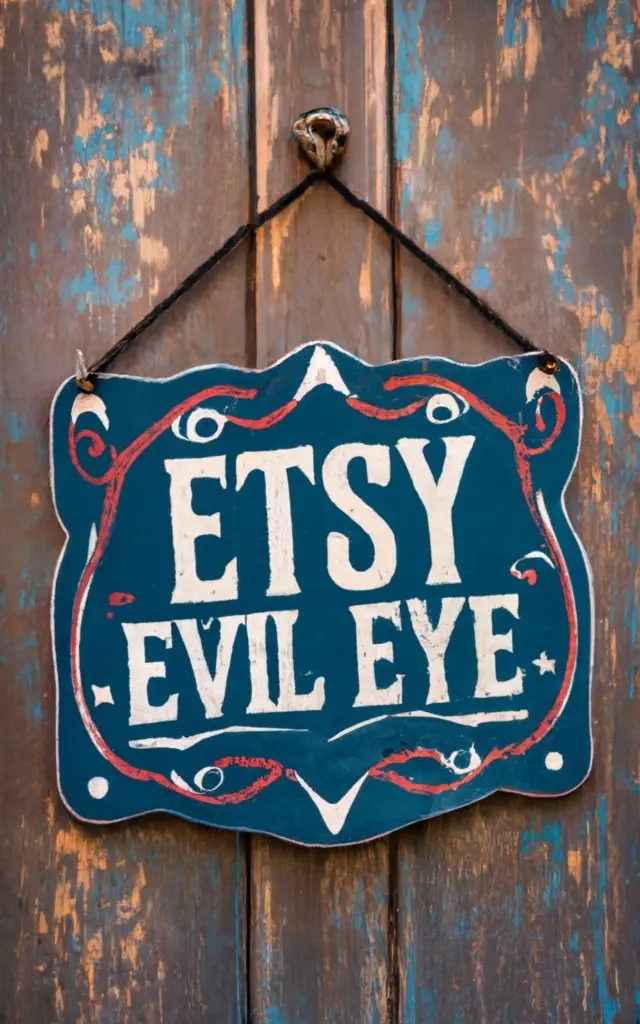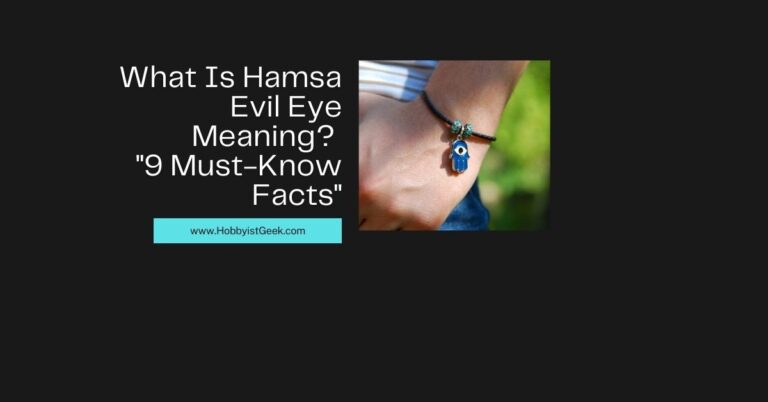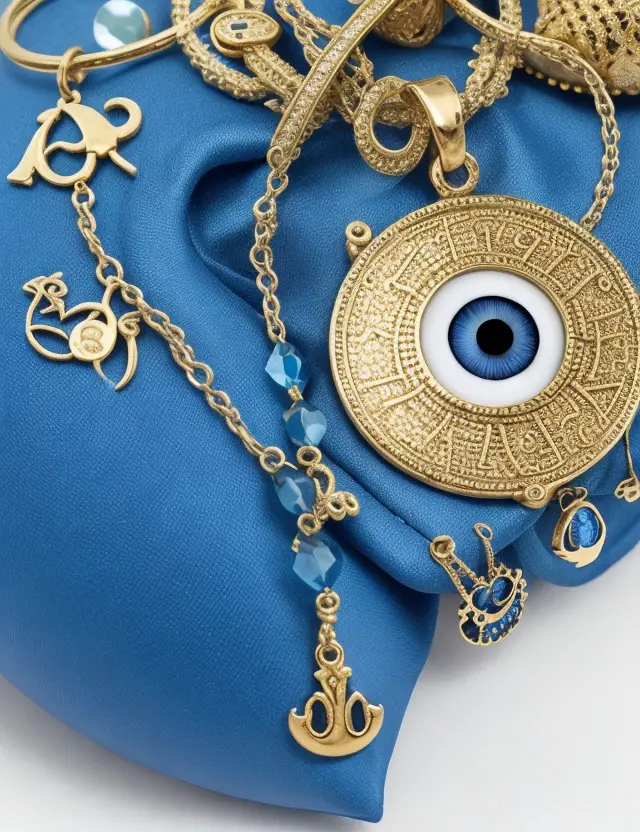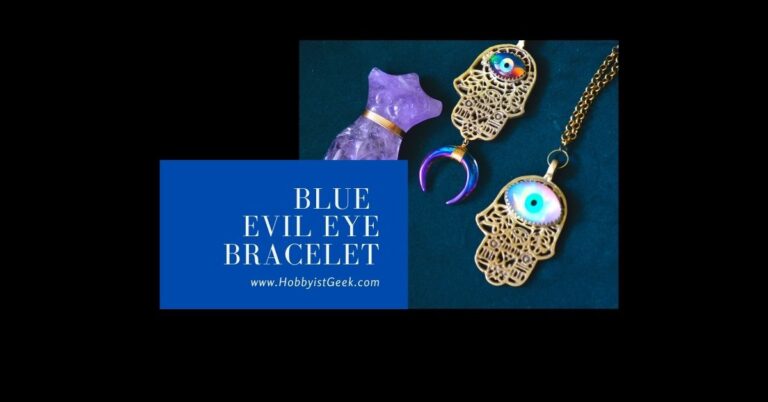Evil Eyes Art: The Allure of Symbolism and Meanings
Introduction
Evil Eyes Art: The Allure of Symbolism and Meanings Evil eyes art, a captivating form of expression, has long intrigued individuals from different cultures and backgrounds.
It is a captivating subject that delves into the realm of mysticism, offering a glimpse into ancient superstitions and beliefs. This article aims to explore the enchanting world of evil eyes art, its historical origins, cultural significance, and the allure it holds for people today.
Definition of Evil Eyes Art
Evil eyes art refers to various artistic representations that depict the symbol known as the “evil eye.” This symbol typically portrays an eye with vivid colors and intricate designs. The term “evil eye” originates from ancient folklore and belief systems that revolve around protecting oneself from negative energy and ill-wishing.
The evil eye is commonly associated with envy or jealousy, believed by many cultures to be capable of causing misfortune or harm upon others. Evil eyes art serves as a visual representation of this protective concept—artworks often feature elaborate motifs adorned with vibrant hues to evoke both fascination and spiritual protection.
Overview of the Allure of Symbolism and Meanings
Symbolism has always possessed an inexplicable allure for humanity. It allows us to convey complex ideas and emotions through abstract representations. In the case of evil eyes art, symbolism plays a significant role in capturing our attention and fascination.
The alluring aspect lies in how these symbolically charged artworks delve into profound human experiences such as vulnerability, spirituality, and protection. Evil eyes art offers both aesthetic pleasure in its intricate designs as well as a deeper connection to ancient beliefs that continue to resonate today.
Through examining this rich tapestry of symbolism and meanings within evil eyes art, we can unlock hidden narratives that connect us not only to our past but also to our present reality. From exploring its historical origins to analyzing its cultural significance, we embark upon a journey that enriches our understanding of the human experience and the power of art.
Subtitle: A Glimpse into Ancient Superstitions
Ancient superstitions are often viewed as archaic remnants of bygone eras. However, delving into evil eyes art allows us to rediscover these ancient beliefs and recognize how they still shape our lives in subtle ways. By exploring the allure of symbolism and meanings within evil eyes art, we uncover fascinating narratives that bridge the gap between past and present, reminding us of our shared human experience.
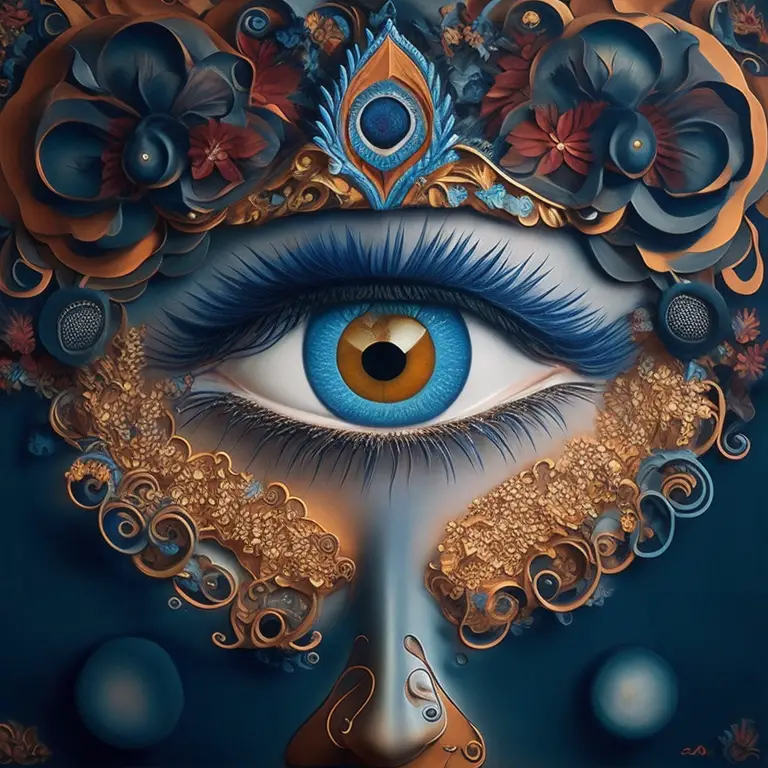
Ancient Mesopotamian Beliefs and Talismans
Subtitle: Unearthing the Origins of Evil Eyes Art In the fertile lands of Mesopotamia, nestled between the Tigris and Euphrates rivers, ancient civilizations thrived and gave birth to various beliefs and practices.
Among these was the concept of the evil eye, a menacing gaze believed to bring misfortune upon those unfortunate enough to be its target. The people of Mesopotamia developed numerous talismans and amulets adorned with protective symbols to ward off this malevolent force.
The ancient Mesopotamians attributed great significance to eyes as powerful conduits through which one’s intentions could be transmitted. They believed that some individuals possessed an innate ability to cast this evil eye upon others, unintentionally or otherwise.
To counteract its effects, they crafted intricate talismans made of precious metals such as gold or silver and encrusted them with mesmerizing gemstones like lapis lazuli or carnelian. These talismans often took the form of stylized eyes, meticulously crafted by skilled artisans.
They were worn as pendants or incorporated into jewelry pieces such as bracelets or rings. The symbolism behind these intricate designs was twofold: they served both as a means of protection against the evil eye’s curse and as a potent representation of divine watchfulness over individuals who sought solace in their power.
Influence of Greek and Roman Mythology
Subtitle: Cultural Transmutation of Evil Eyes Art As civilizations rose and fell across time, so too did their beliefs intertwine and evolve.
Ancient Greek mythology played a pivotal role in shaping the perception of evil eyes art across different eras. One tale tells of Zeus creating mighty Athena from his forehead after consuming Metis – a titaness embodying wisdom – fearing that she had conceived a child who would overthrow him.
Athena, with her piercing gray eyes, became a symbol of wisdom and protection against malevolent forces. The Romans, in turn, adopted many aspects of Greek culture, including their belief in the evil eye.
They revered Minerva, their equivalent of Athena, as the goddess who safeguarded them from harm. Talismans depicting Minerva’s wise gaze were fervently embraced by Roman citizens seeking protection from ill fortune.
This amalgamation of cultures and beliefs led to a gradual spread of evil eyes art beyond its Mesopotamian origins. The ethos surrounding these potent symbols transcended geographical boundaries and found resonance among various civilizations throughout history.
Spread to Middle Eastern Cultures
Subtitle: Gazing Back at Ancient Roots As threads of history intertwined, so did the concept of the evil eye migrate across continents and find fertile ground in Middle Eastern cultures. Mesopotamia’s influence extended eastward with cultural exchanges occurring through trade routes and conquests.
These interactions led to the assimilation and reinterpretation of ancient beliefs concerning the evil eye. In countries like Turkey, Iran, and Syria, where Islamic traditions hold sway, protective talismans known as “nazar” or “nazar boncuk” gained widespread popularity.
These amulets featured an eye-shaped design adorned with vibrant blue hues — a color believed to possess powerful protective properties against envy and malicious intent. The Middle Eastern interpretation also drew inspiration from Arabic folklore and Islamic teachings that emphasized spiritual protection against malevolence.
The intricate designs exuded both beauty and symbolism while serving as tangible reminders that divine forces were watching over individuals who adorned themselves with such ornaments. Evil eyes art had successfully transcended time and cultural barriers through its profound symbolism — forever etching its presence in human history as an enduring talismanic tradition rooted in ancient beliefs spanning multiple civilizations.
Protection against the Evil Eye’s Curse
Beliefs in Envy and Jealousy as Causes of Misfortune
Evil Eyes Art holds immense cultural significance, particularly for its perceived ability to protect against the malevolent effects of the Evil Eye’s curse. Many societies across different regions have long believed that envy and jealousy can cause harm and misfortune befalling others. The Evil Eye, often associated with a malicious glare or envious gaze, is believed to possess the power to bring about illness, accidents, or general bad luck.
Ancient civilizations, from Mesopotamia to Greece and beyond, attributed great weight to the notion that envy could lead to harm. For instance, in ancient Mesopotamian lore, it was believed that individuals who possessed excessive wealth or good fortune would attract the envy of others.
Such envy was thought to manifest itself through curses inflicted by the Evil Eye. People aimed to protect themselves from this danger by employing various symbolic talismans and amulets representative of vigilant eyes.
Talismanic Powers for Warding off Negative Energy
To safeguard against the effects of the Evil Eye’s curse, cultures worldwide developed an array of talismans and amulets featuring vigilant eyes. These protective symbols were believed not only to ward off negativity but also act as powerful shields against envious glares.
One renowned example is the “Nazar Boncuk,” a Turkish tradition that involves using blue glass beads with an eye-like design. These talismans are crafted with meticulous attention to detail and are deeply ingrained within cultural traditions.
They are commonly found incorporated into jewelry designs such as bracelets, necklaces, or pendants worn close to one’s person. By wearing these pieces or displaying them in homes or vehicles, individuals seek protection from any harmful intentions sent their way due to malicious envy.
Spiritual and Religious Associations
Evil Eyes Art also holds significant spiritual and religious associations, connecting it to various belief systems. Islam, Judaism, and Christianity all acknowledge the concept of the Evil Eye and embrace protective measures against its influence.
Within Islam, for instance, references to the Evil Eye can be found in both the Quran and Prophetic traditions. It is believed that seeking protection from the Evil Eye aligns with one’s reliance on Allah’s divine power.
Similarly, in Judaism, the Evil Eye is mentioned in ancient texts like the Talmud, where it is referred to as “Ayin Hara.” Jewish tradition emphasizes using amulets or talismans featuring vigilant eyes for protection against this affliction. For Christians, symbolism associated with vigilant eyes often represents God’s constant watchfulness over His creation.
It serves as a reminder of Divine presence and protection. Whether incorporated into religious artifacts or worn as personal adornments, these symbols evoke a sense of spiritual connection and provide reassurance against negative energies.
Evil Eyes Art strikes a chord across cultures due to its ability to ward off ill-intentions stemming from envy or jealousy. Through various cultural beliefs and practices, individuals seek solace in protective talismans adorned with vigilant eyes.
These amulets not only serve as tangible safeguards but also hold deep spiritual significance by connecting believers with their faith’s teachings on divine protection against malevolent forces. In our next section, we will delve deeper into specific variations of Evil Eyes Art found across different cultures.
Variations in Evil Eyes Art Across Different Cultures
Turkish Nazar Boncuk: The Blue Glass Bead Tradition
Submerged in the rich cultural tapestry of Turkey, the Nazar Boncuk holds a special place in the realm of Evil Eyes Art. In Turkish folklore, this tradition is believed to have originated from ancient Anatolian civilizations.
The Nazar Boncuk, also known as the Blue Glass Bead, is a vibrant talisman created by fusing molten glass and then shaping it into a spherical form. This striking blue bead, with its protective powers against the evil eye’s curse, has become an integral part of Turkish culture.
Origins and Popular Usage
The origins of the Nazar Boncuk can be traced back to ancient Mesopotamian beliefs where blue stones were used as amulets to ward off evil spirits. Over time, this practice found its way into Turkish culture and underwent various adaptations.
Today, you can find Nazar Boncuks adorning almost every aspect of Turkish life – from homes and cars to jewelry and clothing. It is believed that these beads absorb negative energy directed towards those who wear or display them.
Superstitions Surrounding the Color Blue
The choice of the color blue for Nazar Boncuks holds significant superstitious meaning within Turkish culture. It is believed that shades of blue possess powerful protective properties against malevolent forces.
Furthermore, there exists a widely-held belief that evil spirits are unable to tolerate or withstand the color blue due to its association with purity and spirituality. This belief has led to an array of superstitions surrounding not only the Nazar Boncuk but also other objects or items adorned with shades of blue.
Hamsa Hand: The Hand of Fatima or Miriam
The Hamsa Hand, also known as the Hand of Fatima or Miriam, is another intriguing form of Evil Eyes Art that finds its roots in multiple cultures and religions. This ancient symbol, often depicted as a hand with an eye in the center or surrounding it, holds deep significance in Jewish, Islamic, and Christian traditions alike.
Significance in Jewish, Islamic, and Christian Traditions
In Jewish tradition, the Hamsa Hand represents divine protection against the evil eye’s influence. It is associated with Fatima Zahra, the daughter of Prophet Muhammad.
In Islam, it symbolizes the Five Pillars of Faith and acts as a guardian against negative energy. In Christianity, it is linked to Mary’s protection.
Symbolic Depictions and Interpretations
The Hamsa Hand’s symbolic depictions vary across cultures. Some designs may include additional elements such as fish or flowers to represent fertility or luck. The central eye within the hand signifies watchfulness and protection from harm.
The fingers are often spread apart to ward off evil spirits with their collective strength. Evil Eyes Art manifests itself diversely across different cultures through variations like the Turkish Nazar Boncuk and the Hamsa Hand.
These symbols hold immense cultural significance and are deeply rooted in ancient beliefs and traditions. Whether it be through traditional blue glass beads or mystical hand-shaped talismans adorned with an all-seeing eye – these forms of art have transcended time to protect individuals from the malevolent forces of envy and ill-wishing throughout history.
| Aspect | Turkish Nazar Boncuk | Hamsa Hand |
|---|---|---|
| Name | Turkish Nazar Boncuk | Hamsa Hand |
| Origin | Ancient Anatolian civilizations | Multiple cultures and religions |
| Description | Blue glass bead talisman | Hand-shaped symbol with an eye |
| Usage | Protects against the evil eye’s curse | Offers protection from negative energy |
| Origins and Adaptations | Derived from Mesopotamian beliefs | Rooted in Jewish, Islamic, and Christian traditions |
| Superstitions | Belief in blue’s protective properties | Protection against evil eye’s influence in various traditions |
| Symbolism | Protection, purity, spirituality | Divine protection and watchfulness |
| Variations | Nazar Boncuks adorn various aspects of Turkish life | May include additional elements like fish or flowers |
| Cultural Significance | Integral part of Turkish culture | Significant in Jewish, Islamic, and Christian traditions |
| Common Usage | Adorns homes, cars, jewelry, clothing | Used as a talisman or decoration |
These two symbols, the Turkish Nazar Boncuk and the Hamsa Hand share a common theme of protection against negative influences and have deep cultural significance in their respective contexts.
Social Impact: Modern Interpretations and Commercialization
Popularity in Fashion Industry
In recent years, Evil Eyes Art has gained immense popularity in the fashion industry. The mesmerizing allure of the evil eye symbol has captivated designers and fashion enthusiasts alike. From clothing to accessories, you can find this captivating symbol adorning a wide range of products.
Celebrities have played a significant role in fueling this trend by sporting evil eye jewelry on red carpets and magazine covers. This surge in popularity has propelled evil eyes into the mainstream consciousness, transforming it from a niche cultural symbol to a global fashion statement.
Evil Eye Jewelry Trends
One area where the influence of evil eyes is particularly prominent is jewelry. Evil eye bracelets, necklaces, earrings, and rings have become must-have items for those seeking both style and spiritual protection. Jewelry designers have creatively incorporated the evil eye symbol into their designs by using different materials such as precious metals, gemstones, enamel, or even glass beads with intricate detailing to enhance its aesthetic appeal.
These jewelry pieces not only reflect personal style but also serve as talismans against negative energy. The delicate balance between fashionable design elements and symbolic meaning has made evil eye jewelry an ideal accessory for those who desire both inner strength and outward beauty.
Cultural Appropriation Concerns
With the widespread adoption of evil eyes in popular culture comes concerns about cultural appropriation. The origins of this ancient symbol are deeply rooted in various cultures like Greece, Turkey, Middle Eastern countries, and others where it holds significant religious or spiritual significance.
As this trend continues to gain momentum worldwide, it is crucial to respect the cultural context from which the symbol emerged. Cultural appropriation occurs when a sacred or meaningful object is adopted without understanding or honoring its origin.
If you enjoyed this informative article I know you will love:
Evil Eye Bracelet Color Meaning: How Colors Influence Your Life!
It’s essential for individuals embracing this fashion statement to educate themselves about its history, cultural significance, and the communities it represents. Appreciating the beauty of evil eyes should go hand in hand with cultural sensitivity and understanding.
Psychological Perspectives on Evil Eyes Art
The power of symbolism cannot be underestimated when examining the impact of evil eye art on human psychology. Throughout history, symbols have been used to convey deep emotions, beliefs, and protection against perceived threats. The evil eye is no exception – its centuries-old reputation as a talisman against envy and ill fortune has ingrained it deeply into our collective subconscious.
For some individuals, owning or wearing evil eye jewelry can serve as a psychological anchor that provides a sense of security and protection from negative energy. The visual reminder of this ancient symbol can evoke feelings of calmness and reassurance during challenging times.
Moreover, incorporating evil eyes into daily life can offer a symbolic connection to one’s personal beliefs or spirituality. On the other hand, psychological perspectives also acknowledge that our individual interpretations may vary significantly.
Some people may find comfort in embracing the symbolism associated with evil eyes, while others may see them merely as fashionable accessories devoid of deeper meaning. Ultimately, each person’s perception is unique and influenced by their own experiences and beliefs.
Evil Eyes Art continues to fascinate society with its rich symbolism and captivating designs. Its integration into the fashion industry brings this ancient symbol to new heights of popularity while also raising important questions about cultural appreciation versus appropriation.
From a psychological standpoint, the power of symbols on human psychology cannot be denied – whether we see them as mere adornments or powerful protectors depends on our personal interpretations. As this trend endures, let us strive for both an appreciation for its beauty and respect for its origins in order to honor its profound significance across cultures throughout history.
Conclusion
Recapitulation of the Allure
Throughout history, Evil Eyes Art has captivated people from different cultures with its rich symbolism and profound meanings. As we’ve explored in this article, the allure of Evil Eyes Art lies in its origins, cultural significance, variations across different cultures, social impact, and psychological perspectives.
It serves as a powerful talisman against the curse of envy and jealousy while also representing divine protection in various faiths. The historical origins of Evil Eyes Art trace back to ancient Mesopotamia, where beliefs in talismans for warding off evil spirits and protecting against misfortune were first documented.
The influence of Greek and Roman mythology further contributed to the spread and adoption of the Evil Eye concept among Middle Eastern cultures. Understanding these roots helps us appreciate the depth and longevity of this fascinating art form.
The cultural significance of Evil Eyes Art is immense. For centuries, individuals have sought protection against the malevolent gaze by adorning themselves or their surroundings with talismans featuring Evil Eye motifs.
This practice highlights a universal belief in envy’s destructive power and the need for spiritual guardianship. Moreover, religious associations with Judaism, Islam, Christianity add a deeper layer to its meaning as a symbol of divine protection.
Evil Eyes Art varies across different cultures, with each having their own unique interpretations and symbols associated with protection against the curse. The Turkish Nazar Boncuk tradition emphasizes blue glass beads as a common talismanic item believed to deflect negative energy.
Similarly, the Hamsa Hand represents an ancient hand-shaped amulet found in Jewish, Islamic, and Christian traditions that wards off evil forces through its protective symbolism. In modern times, Evil Eyes Art has made significant social impacts through its presence in fashion trends like evil eye jewelry.
However, it is crucial to navigate cultural appropriation concerns thoughtfully when incorporating these symbols into commercial products. Additionally, from a psychological perspective, the power of symbolism in Evil Eyes Art can have a profound impact on personal beliefs and overall well-being, providing individuals with a sense of protection and reassurance.
The allure of Evil Eyes Art lies not only in its aesthetic appeal but also in its deep-rooted symbolism and cultural significance. Despite evolving over centuries and adapting to contemporary contexts, the essence of Evil Eyes Art remains intact – to protect individuals from malevolent intentions and provide a sense of spiritual guidance.
Its enduring popularity across cultures serves as a testament to its timeless allure. So why not embrace this ancient charm and bask in the comforting belief that we are shielded from harm by our very own talismanic guardian?
- Evil Eye Hand: Unveiling the Mystical Origins and Meanings - February 2, 2024
- Amegreen Amethyst Meaning: Discover the Hidden Magic! - February 2, 2024
- Is The Evil Eye Bad?: A Deep Dive into Evil Eye Taboos - February 2, 2024


